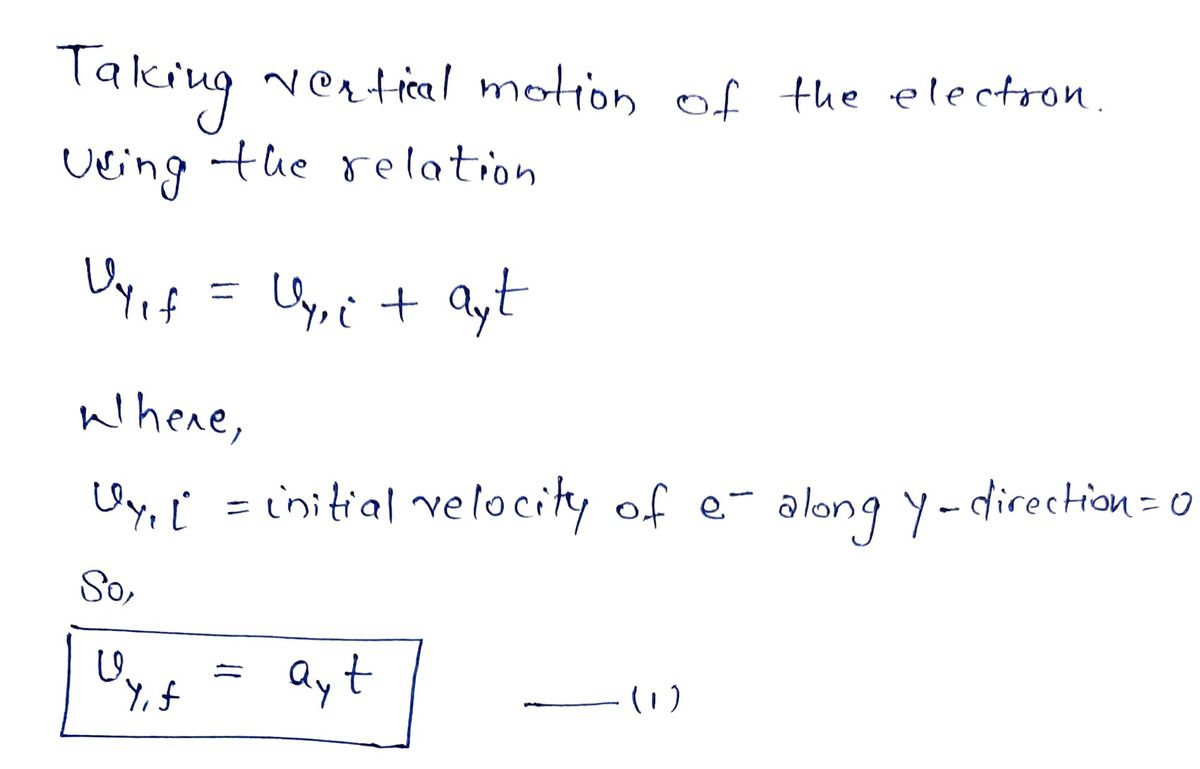The figure shows an electron passing between two charged metal plates that create a 108 N/C vertical electric field perpendicular to the electron's original horizontal velocity. (These can be used to change the electron's direction, such as in an oscilloscope.) The initial speed of the electron is 3.1 x 10 m/s, and the horizontal distance it travels in the uniform field is 4.8 cm. What is the vertical component of its final velocity in m/s?
The figure shows an electron passing between two charged metal plates that create a 108 N/C vertical electric field perpendicular to the electron's original horizontal velocity. (These can be used to change the electron's direction, such as in an oscilloscope.) The initial speed of the electron is 3.1 x 10 m/s, and the horizontal distance it travels in the uniform field is 4.8 cm. What is the vertical component of its final velocity in m/s?
College Physics
11th Edition
ISBN:9781305952300
Author:Raymond A. Serway, Chris Vuille
Publisher:Raymond A. Serway, Chris Vuille
Chapter1: Units, Trigonometry. And Vectors
Section: Chapter Questions
Problem 1CQ: Estimate the order of magnitude of the length, in meters, of each of the following; (a) a mouse, (b)...
Related questions
Question
![**Educational Transcription:**
The figure illustrates an electron traveling between two charged metal plates that produce a \(108 \, \text{N/C}\) vertical electric field, which is perpendicular to the electron's initial horizontal velocity. This setup is commonly used to alter the electron's trajectory, such as in an oscilloscope. The electron's initial speed is \(3.1 \times 10^6 \, \text{m/s}\), and it moves a horizontal distance of \(4.8 \, \text{cm}\) in the uniform field.
**Diagram Explanation:**
- The diagram shows two parallel plates with a positive charge on the top plate and a negative charge on the bottom plate.
- An electron (\(e^-\)) is moving from left to right, entering between the plates with an initial horizontal velocity \(v_0\).
- As the electron passes through the plates, its path curves upward due to the influence of the vertical electric field.
- The vector \(v_1\) represents the electron's final velocity, making an angle \(\theta\) with the horizontal.
**Question:**
What is the vertical component of its final velocity in \(\text{m/s}\)?
**Equation:**
\(V_{y,f} =\) [to be calculated]
This material is designed for educational use to help students understand the motion of charged particles in electric fields.](/v2/_next/image?url=https%3A%2F%2Fcontent.bartleby.com%2Fqna-images%2Fquestion%2F3a328885-7641-4d6d-85af-435d99e02dcf%2F0911eece-b7da-410b-90e4-91cae51c4239%2Ff2oc97l_processed.jpeg&w=3840&q=75)
Transcribed Image Text:**Educational Transcription:**
The figure illustrates an electron traveling between two charged metal plates that produce a \(108 \, \text{N/C}\) vertical electric field, which is perpendicular to the electron's initial horizontal velocity. This setup is commonly used to alter the electron's trajectory, such as in an oscilloscope. The electron's initial speed is \(3.1 \times 10^6 \, \text{m/s}\), and it moves a horizontal distance of \(4.8 \, \text{cm}\) in the uniform field.
**Diagram Explanation:**
- The diagram shows two parallel plates with a positive charge on the top plate and a negative charge on the bottom plate.
- An electron (\(e^-\)) is moving from left to right, entering between the plates with an initial horizontal velocity \(v_0\).
- As the electron passes through the plates, its path curves upward due to the influence of the vertical electric field.
- The vector \(v_1\) represents the electron's final velocity, making an angle \(\theta\) with the horizontal.
**Question:**
What is the vertical component of its final velocity in \(\text{m/s}\)?
**Equation:**
\(V_{y,f} =\) [to be calculated]
This material is designed for educational use to help students understand the motion of charged particles in electric fields.
Expert Solution
Step 1

Step by step
Solved in 3 steps with 4 images

Knowledge Booster
Learn more about
Need a deep-dive on the concept behind this application? Look no further. Learn more about this topic, physics and related others by exploring similar questions and additional content below.Recommended textbooks for you

College Physics
Physics
ISBN:
9781305952300
Author:
Raymond A. Serway, Chris Vuille
Publisher:
Cengage Learning

University Physics (14th Edition)
Physics
ISBN:
9780133969290
Author:
Hugh D. Young, Roger A. Freedman
Publisher:
PEARSON

Introduction To Quantum Mechanics
Physics
ISBN:
9781107189638
Author:
Griffiths, David J., Schroeter, Darrell F.
Publisher:
Cambridge University Press

College Physics
Physics
ISBN:
9781305952300
Author:
Raymond A. Serway, Chris Vuille
Publisher:
Cengage Learning

University Physics (14th Edition)
Physics
ISBN:
9780133969290
Author:
Hugh D. Young, Roger A. Freedman
Publisher:
PEARSON

Introduction To Quantum Mechanics
Physics
ISBN:
9781107189638
Author:
Griffiths, David J., Schroeter, Darrell F.
Publisher:
Cambridge University Press

Physics for Scientists and Engineers
Physics
ISBN:
9781337553278
Author:
Raymond A. Serway, John W. Jewett
Publisher:
Cengage Learning

Lecture- Tutorials for Introductory Astronomy
Physics
ISBN:
9780321820464
Author:
Edward E. Prather, Tim P. Slater, Jeff P. Adams, Gina Brissenden
Publisher:
Addison-Wesley

College Physics: A Strategic Approach (4th Editio…
Physics
ISBN:
9780134609034
Author:
Randall D. Knight (Professor Emeritus), Brian Jones, Stuart Field
Publisher:
PEARSON